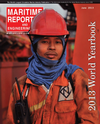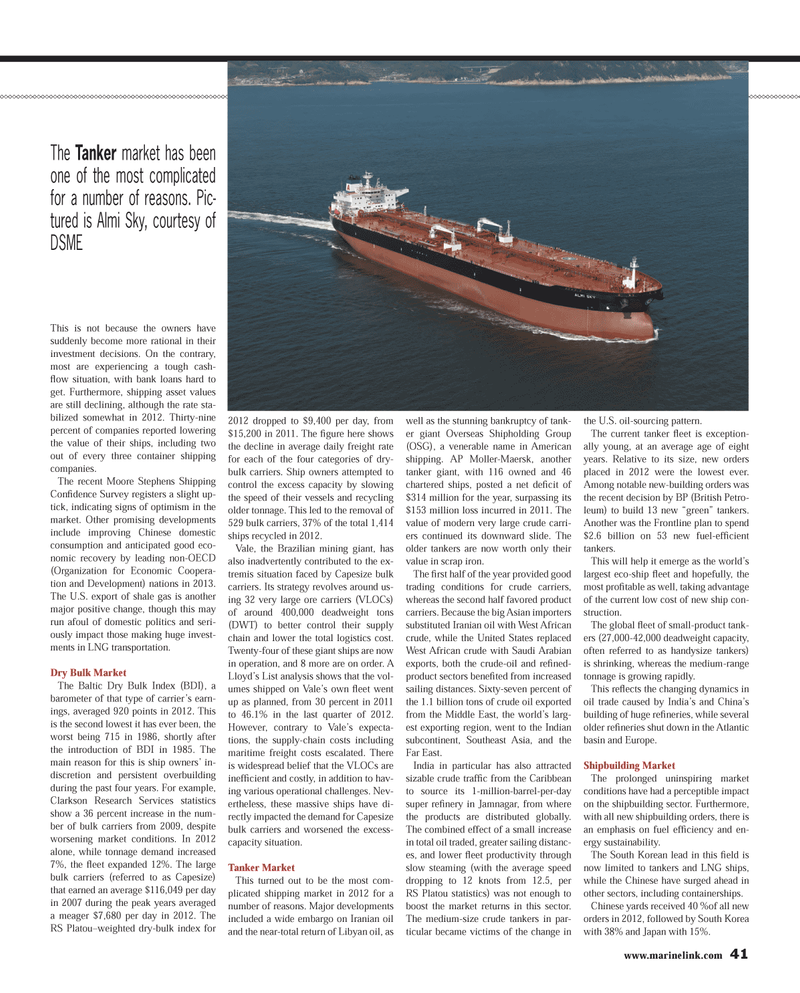
Page 41: of Maritime Reporter Magazine (June 2013)
Annual World Yearbook
Read this page in Pdf, Flash or Html5 edition of June 2013 Maritime Reporter Magazine
www.marinelink.com 41This is not because the owners have suddenly become more rational in their investment decisions. On the contrary, most are experiencing a tough cash-ß ow situation, with bank loans hard to get. Furthermore, shipping asset values are still declining, although the rate sta-bilized somewhat in 2012. Thirty-nine percent of companies reported lowering the value of their ships, including two out of every three container shipping companies.The recent Moore Stephens Shipping ConÞ dence Survey registers a slight up- tick, indicating signs of optimism in the market. Other promising developments include improving Chinese domestic consumption and anticipated good eco-nomic recovery by leading non-OECD (Organization for Economic Coopera- tion and Development) nations in 2013. The U.S. export of shale gas is another major positive change, though this may run afoul of domestic politics and seri-ously impact those making huge invest-ments in LNG transportation.Dry Bulk MarketThe Baltic Dry Bulk Index (BDI), a barometer of that type of carrier?s earn- ings, averaged 920 points in 2012. This is the second lowest it has ever been, the worst being 715 in 1986, shortly after the introduction of BDI in 1985. The main reason for this is ship owners? in- discretion and persistent overbuilding during the past four years. For example, Clarkson Research Services statistics show a 36 percent increase in the num-ber of bulk carriers from 2009, despite worsening market conditions. In 2012 alone, while tonnage demand increased 7%, the ß eet expanded 12%. The large bulk carriers (referred to as Capesize) that earned an average $116,049 per day in 2007 during the peak years averaged a meager $7,680 per day in 2012. The RS Platou?weighted dry-bulk index for 2012 dropped to $9,400 per day, from $15,200 in 2011. The Þ gure here shows the decline in average daily freight rate for each of the four categories of dry-bulk carriers. Ship owners attempted to control the excess capacity by slowing the speed of their vessels and recycling older tonnage. This led to the removal of 529 bulk carriers, 37% of the total 1,414 ships recycled in 2012.Vale, the Brazilian mining giant, has also inadvertently contributed to the ex-tremis situation faced by Capesize bulk carriers. Its strategy revolves around us-ing 32 very large ore carriers (VLOCs) of around 400,000 deadweight tons (DWT) to better control their supply chain and lower the total logistics cost. Twenty-four of these giant ships are now in operation, and 8 more are on order. A Lloyd?s List analysis shows that the vol- umes shipped on Vale?s own ß eet went up as planned, from 30 percent in 2011 to 46.1% in the last quarter of 2012. However, contrary to Vale?s expecta- tions, the supply-chain costs including maritime freight costs escalated. There is widespread belief that the VLOCs are inefÞ cient and costly, in addition to hav- ing various operational challenges. Nev-ertheless, these massive ships have di-rectly impacted the demand for Capesize bulk carriers and worsened the excess-capacity situation.Tanker Market This turned out to be the most com-plicated shipping market in 2012 for a number of reasons. Major developments included a wide embargo on Iranian oil and the near-total return of Libyan oil, as well as the stunning bankruptcy of tank-er giant Overseas Shipholding Group (OSG), a venerable name in American shipping. AP Moller-Maersk, another tanker giant, with 116 owned and 46 chartered ships, posted a net deÞ cit of $314 million for the year, surpassing its $153 million loss incurred in 2011. The value of modern very large crude carri- ers continued its downward slide. The older tankers are now worth only their value in scrap iron.The Þ rst half of the year provided good trading conditions for crude carriers, whereas the second half favored product carriers. Because the big Asian importers substituted Iranian oil with West African crude, while the United States replaced West African crude with Saudi Arabian exports, both the crude-oil and reÞ ned-product sectors beneÞ ted from increased sailing distances. Sixty-seven percent of the 1.1 billion tons of crude oil exported from the Middle East, the world?s larg- est exporting region, went to the Indian subcontinent, Southeast Asia, and the Far East.India in particular has also attracted sizable crude trafÞ c from the Caribbean to source its 1-million-barrel-per-day super reÞ nery in Jamnagar, from where the products are distributed globally. The combined effect of a small increase in total oil traded, greater sailing distanc-es, and lower ß eet productivity through slow steaming (with the average speed dropping to 12 knots from 12.5, per RS Platou statistics) was not enough to boost the market returns in this sector. The medium-size crude tankers in par- ticular became victims of the change in the U.S. oil-sourcing pattern.The current tanker ß eet is exception- ally young, at an average age of eight years. Relative to its size, new orders placed in 2012 were the lowest ever. Among notable new-building orders was the recent decision by BP (British Petro- leum) to build 13 new ?green? tankers. Another was the Frontline plan to spend $2.6 billion on 53 new fuel-efÞ cient tankers. This will help it emerge as the world?s largest eco-ship ß eet and hopefully, the most proÞ table as well, taking advantage of the current low cost of new ship con-struction. The global ß eet of small-product tank- ers (27,000-42,000 deadweight capacity, often referred to as handysize tankers) is shrinking, whereas the medium-range tonnage is growing rapidly. This reß ects the changing dynamics in oil trade caused by India?s and China?s building of huge reÞ neries, while several older reÞ neries shut down in the Atlantic basin and Europe.Shipbuilding MarketThe prolonged uninspiring market conditions have had a perceptible impact on the shipbuilding sector. Furthermore, with all new shipbuilding orders, there is an emphasis on fuel efÞ ciency and en- ergy sustainability. The South Korean lead in this Þ eld is now limited to tankers and LNG ships, while the Chinese have surged ahead in other sectors, including containerships. Chinese yards received 40 %of all new orders in 2012, followed by South Korea with 38% and Japan with 15%.The Tanker market has been one of the most complicated for a number of reasons. Pic- tured is Almi Sky, courtesy of DSMEMR #6 (34-41).indd 41MR #6 (34-41).indd 415/30/2013 1:08:54 PM5/30/2013 1:08:54 PM

 40
40

 42
42
